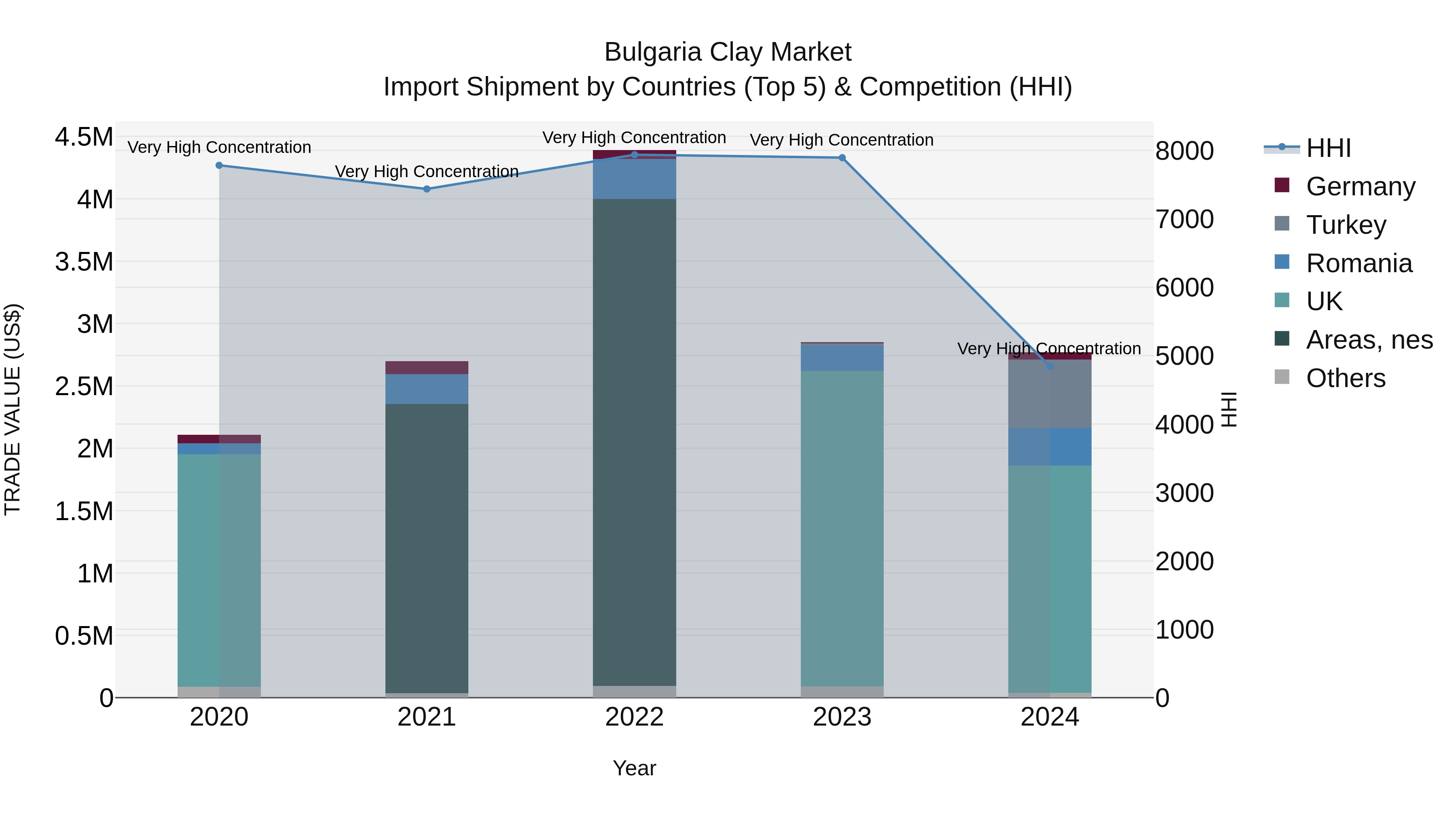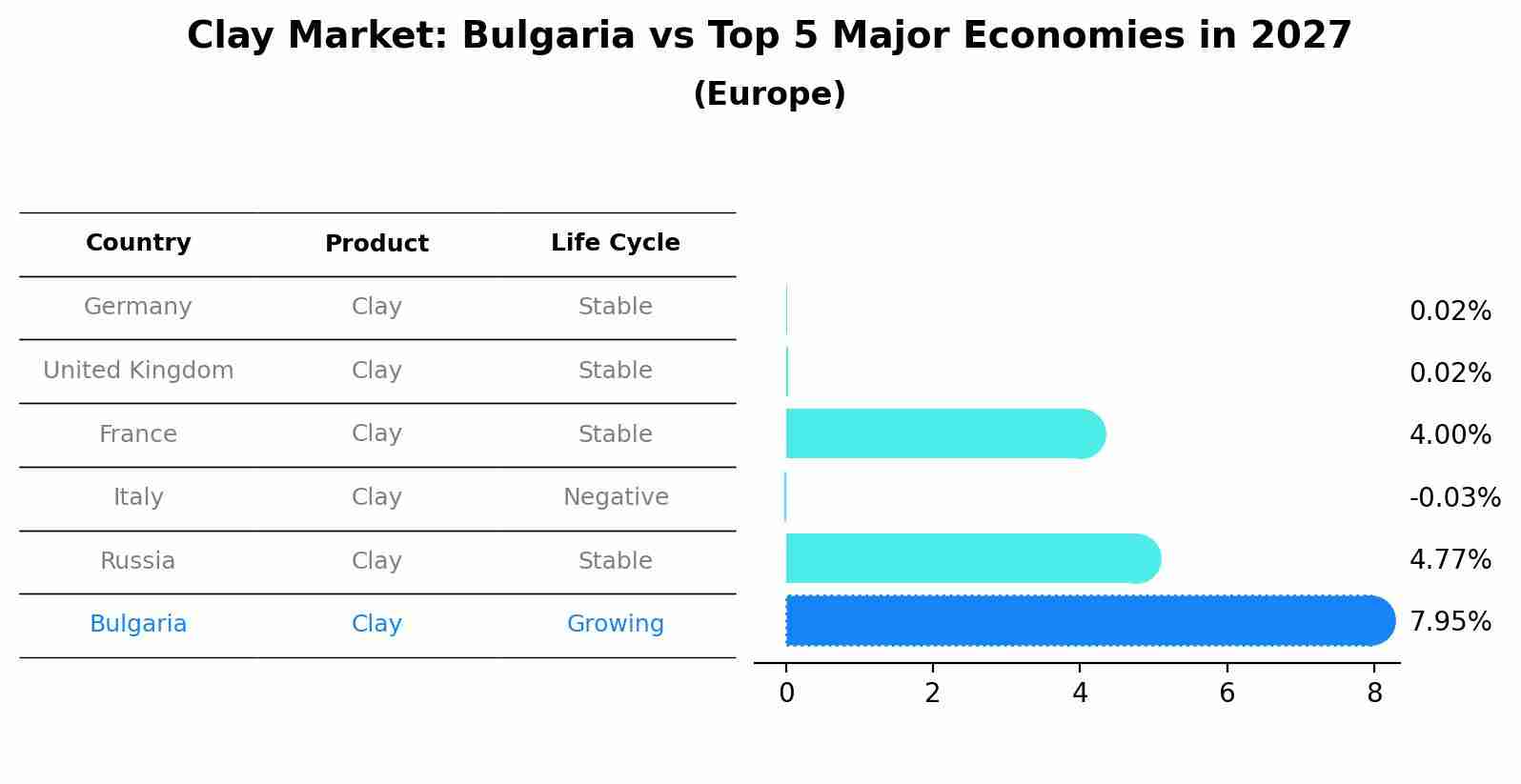Bulgaria Clay Market (2025-2031) | Share, Segmentation, Outlook, Value, Industry, Size, Companies, Revenue, Growth, Forecast, Trends & Analysis
| Product Code: ETC5257634 | Publication Date: Nov 2023 | Updated Date: Oct 2025 | Product Type: Market Research Report | |
| Publisher: 6Wresearch | Author: Bhawna Singh | No. of Pages: 60 | No. of Figures: 30 | No. of Tables: 5 |
Bulgaria Clay Market Top 5 Importing Countries and Market Competition (HHI) Analysis
Bulgaria`s clay import Market Top 5 Importing Countries and Market Competition (HHI) Analysis in 2024 continued to see significant concentration with top exporting countries being UK, Turkey, Romania, Germany, and Metropolitan France. Despite a slight decline in growth rate from 2023, the compound annual growth rate (CAGR) over the past four years has been a promising 7.04%. The high Herfindahl-Hirschman Index (HHI) indicates a concentrated Market Top 5 Importing Countries and Market Competition (HHI) Analysis structure, suggesting the dominance of these key exporting countries in supplying clay to Bulgaria. This data highlights the significance of these trade relationships and the potential implications for the Bulgarian clay import Market Top 5 Importing Countries and Market Competition (HHI) Analysis in the coming years.

Clay Market: Bulgaria vs Top 5 Major Economies in 2027 (Europe)
In the Europe region, the Clay market in Bulgaria is projected to expand at a growing growth rate of 7.95% by 2027. The largest economy is Germany, followed by United Kingdom, France, Italy and Russia.

Bulgaria Clay Market Overview
The clay market in Bulgaria includes the production and use of clay for various applications, including ceramics, construction, and pottery. The market is influenced by demand from these industries, trends in ceramic and construction materials, and advancements in clay processing and formulations.
Drivers of the market
The clay market in Bulgaria is driven by its applications in construction, ceramics, and industrial processes. The demand for clay in manufacturing bricks, tiles, and pottery supports market growth. Additionally, the use of clay in various industrial applications and advancements in clay processing technologies contribute to market expansion.
Challenges of the market
The clay market in Bulgaria faces several challenges, primarily related to the variability in raw material quality and the environmental impact of clay extraction. The quality of clay deposits can vary significantly, affecting the consistency and performance of the final products. Additionally, the extraction and processing of clay can have significant environmental impacts, including habitat disruption, soil erosion, and water pollution, which can lead to stricter regulations and higher operational costs. The market also faces competition from alternative materials, such as synthetic clays and other mineral-based products, which can offer similar properties with potentially lower environmental impacts. Moreover, the market is influenced by fluctuations in the construction and ceramics industries, which are major consumers of clay.
Government Policy of the market
In Bulgaria, the clay market is regulated to ensure the quality and safety of clay used in various applications, including construction and ceramics. The government sets standards for the extraction, processing, and use of clay to ensure it meets industry requirements and environmental regulations.
Key Highlights of the Report:
- Bulgaria Clay Market Outlook
- Market Size of Bulgaria Clay Market, 2024
- Forecast of Bulgaria Clay Market, 2031
- Historical Data and Forecast of Bulgaria Clay Revenues & Volume for the Period 2021-2031
- Bulgaria Clay Market Trend Evolution
- Bulgaria Clay Market Drivers and Challenges
- Bulgaria Clay Price Trends
- Bulgaria Clay Porter`s Five Forces
- Bulgaria Clay Industry Life Cycle
- Historical Data and Forecast of Bulgaria Clay Market Revenues & Volume By Application for the Period 2021-2031
- Historical Data and Forecast of Bulgaria Clay Market Revenues & Volume By Tableware for the Period 2021-2031
- Historical Data and Forecast of Bulgaria Clay Market Revenues & Volume By Sanitary ware for the Period 2021-2031
- Historical Data and Forecast of Bulgaria Clay Market Revenues & Volume By Medical applications for the Period 2021-2031
- Historical Data and Forecast of Bulgaria Clay Market Revenues & Volume By End Use for the Period 2021-2031
- Historical Data and Forecast of Bulgaria Clay Market Revenues & Volume By Ceramic and for the Period 2021-2031
- Historical Data and Forecast of Bulgaria Clay Market Revenues & Volume By Non-ceramic for the Period 2021-2031
- Bulgaria Clay Import Export Trade Statistics
- Market Opportunity Assessment By Application
- Market Opportunity Assessment By End Use
- Bulgaria Clay Top Companies Market Share
- Bulgaria Clay Competitive Benchmarking By Technical and Operational Parameters
- Bulgaria Clay Company Profiles
- Bulgaria Clay Key Strategic Recommendations
Frequently Asked Questions About the Market Study (FAQs):
1 Executive Summary |
2 Introduction |
2.1 Key Highlights of the Report |
2.2 Report Description |
2.3 Market Scope & Segmentation |
2.4 Research Methodology |
2.5 Assumptions |
3 Bulgaria Clay Market Overview |
3.1 Bulgaria Country Macro Economic Indicators |
3.2 Bulgaria Clay Market Revenues & Volume, 2021 & 2031F |
3.3 Bulgaria Clay Market - Industry Life Cycle |
3.4 Bulgaria Clay Market - Porter's Five Forces |
3.5 Bulgaria Clay Market Revenues & Volume Share, By Application, 2021 & 2031F |
3.6 Bulgaria Clay Market Revenues & Volume Share, By End Use, 2021 & 2031F |
4 Bulgaria Clay Market Dynamics |
4.1 Impact Analysis |
4.2 Market Drivers |
4.2.1 Increasing demand for ceramics and construction materials |
4.2.2 Growth in infrastructure development projects in Bulgaria |
4.2.3 Rising focus on sustainable and eco-friendly building materials |
4.3 Market Restraints |
4.3.1 Fluctuations in raw material prices |
4.3.2 Competition from alternative materials like plastics and composites |
4.3.3 Regulatory challenges related to environmental impact and mining practices |
5 Bulgaria Clay Market Trends |
6 Bulgaria Clay Market Segmentations |
6.1 Bulgaria Clay Market, By Application |
6.1.1 Overview and Analysis |
6.1.2 Bulgaria Clay Market Revenues & Volume, By Tableware, 2021-2031F |
6.1.3 Bulgaria Clay Market Revenues & Volume, By Sanitary ware, 2021-2031F |
6.1.4 Bulgaria Clay Market Revenues & Volume, By Medical applications, 2021-2031F |
6.2 Bulgaria Clay Market, By End Use |
6.2.1 Overview and Analysis |
6.2.2 Bulgaria Clay Market Revenues & Volume, By Ceramic and, 2021-2031F |
6.2.3 Bulgaria Clay Market Revenues & Volume, By Non-ceramic, 2021-2031F |
7 Bulgaria Clay Market Import-Export Trade Statistics |
7.1 Bulgaria Clay Market Export to Major Countries |
7.2 Bulgaria Clay Market Imports from Major Countries |
8 Bulgaria Clay Market Key Performance Indicators |
8.1 Average selling price of clay products |
8.2 Number of new construction projects using clay materials |
8.3 Percentage of clay products meeting sustainability standards |
8.4 Innovation rate in clay product development |
8.5 Export/import volume of clay products in Bulgaria |
9 Bulgaria Clay Market - Opportunity Assessment |
9.1 Bulgaria Clay Market Opportunity Assessment, By Application, 2021 & 2031F |
9.2 Bulgaria Clay Market Opportunity Assessment, By End Use, 2021 & 2031F |
10 Bulgaria Clay Market - Competitive Landscape |
10.1 Bulgaria Clay Market Revenue Share, By Companies, 2024 |
10.2 Bulgaria Clay Market Competitive Benchmarking, By Operating and Technical Parameters |
11 Company Profiles |
12 Recommendations | 13 Disclaimer |
- Single User License$ 1,995
- Department License$ 2,400
- Site License$ 3,120
- Global License$ 3,795
Search
Related Reports
- ASEAN and Thailand Brain Health Supplements Market (2025-2031) | Strategy, Consumer Insights, Analysis, Investment Trends, Opportunities, Growth, Size, Share, Industry, Revenue, Segments, Value, Segmentation, Supply, Forecast, Restraints, Outlook, Competition, Drivers, Trends, Demand, Pricing Analysis, Competitive, Strategic Insights, Companies, Challenges
- ASEAN Bearings Market (2025-2031) | Strategy, Consumer Insights, Analysis, Investment Trends, Opportunities, Growth, Size, Share, Industry, Revenue, Segments, Value, Segmentation, Supply, Forecast, Restraints, Outlook, Competition, Drivers, Trends, Demand, Pricing Analysis, Competitive, Strategic Insights, Companies, Challenges
- Europe Flooring Market (2025-2031) | Outlook, Share, Industry, Trends, Forecast, Companies, Revenue, Size, Analysis, Growth & Value
- Saudi Arabia Manlift Market (2025-2031) | Outlook, Size, Growth, Trends, Companies, Industry, Revenue, Value, Share, Forecast & Analysis
- Uganda Excavator, Crane, and Wheel Loaders Market (2025-2031) | Strategy, Consumer Insights, Analysis, Investment Trends, Opportunities, Growth, Size, Share, Industry, Revenue, Segments, Value, Segmentation, Supply, Forecast, Restraints, Outlook, Competition, Drivers, Trends, Demand, Pricing Analysis, Competitive, Strategic Insights, Companies, Challenges
- Rwanda Excavator, Crane, and Wheel Loaders Market (2025-2031) | Strategy, Consumer Insights, Analysis, Investment Trends, Opportunities, Growth, Size, Share, Industry, Revenue, Segments, Value, Segmentation, Supply, Forecast, Restraints, Outlook, Competition, Drivers, Trends, Demand, Pricing Analysis, Competitive, Strategic Insights, Companies, Challenges
- Kenya Excavator, Crane, and Wheel Loaders Market (2025-2031) | Strategy, Consumer Insights, Analysis, Investment Trends, Opportunities, Growth, Size, Share, Industry, Revenue, Segments, Value, Segmentation, Supply, Forecast, Restraints, Outlook, Competition, Drivers, Trends, Demand, Pricing Analysis, Competitive, Strategic Insights, Companies, Challenges
- Angola Excavator, Crane, and Wheel Loaders Market (2025-2031) | Strategy, Consumer Insights, Analysis, Investment Trends, Opportunities, Growth, Size, Share, Industry, Revenue, Segments, Value, Segmentation, Supply, Forecast, Restraints, Outlook, Competition, Drivers, Trends, Demand, Pricing Analysis, Competitive, Strategic Insights, Companies, Challenges
- Israel Intelligent Transport System Market (2025-2031) | Strategy, Consumer Insights, Analysis, Investment Trends, Opportunities, Growth, Size, Share, Industry, Revenue, Segments, Value, Segmentation, Supply, Forecast, Restraints, Outlook, Competition, Drivers, Trends, Demand, Pricing Analysis, Competitive, Strategic Insights, Companies, Challenges
- Uganda Precast and Aggregate Market (2025-2031) | Strategy, Consumer Insights, Analysis, Investment Trends, Opportunities, Growth, Size, Share, Industry, Revenue, Segments, Value, Segmentation, Supply, Forecast, Restraints, Outlook, Competition, Drivers, Trends, Demand, Pricing Analysis, Competitive, Strategic Insights, Companies, Challenges
Industry Events and Analyst Meet
Our Clients
Whitepaper
- Middle East & Africa Commercial Security Market Click here to view more.
- Middle East & Africa Fire Safety Systems & Equipment Market Click here to view more.
- GCC Drone Market Click here to view more.
- Middle East Lighting Fixture Market Click here to view more.
- GCC Physical & Perimeter Security Market Click here to view more.
6WResearch In News
- Doha a strategic location for EV manufacturing hub: IPA Qatar
- Demand for luxury TVs surging in the GCC, says Samsung
- Empowering Growth: The Thriving Journey of Bangladesh’s Cable Industry
- Demand for luxury TVs surging in the GCC, says Samsung
- Video call with a traditional healer? Once unthinkable, it’s now common in South Africa
- Intelligent Buildings To Smooth GCC’s Path To Net Zero













